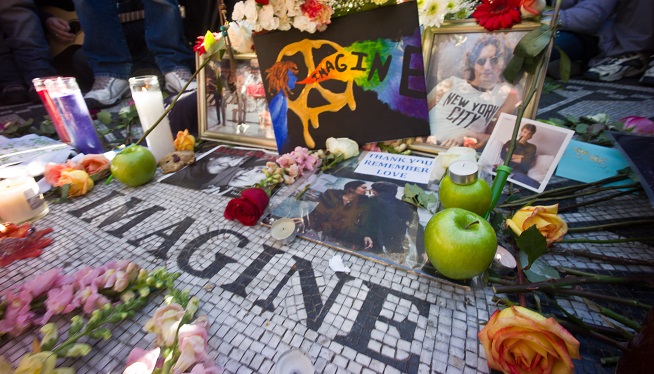NEW YORK — (CNN) There was a voice in his head, a gun in his hand, and John Lennon’s wife right in front of him. Mark David Chapman knew exactly what he was doing when he decided to take the life of one of the world’s most beloved musicians.
“When the car pulled up and Yoko got out, something in the back of my mind was going ‘Do it, do it, do it,'” he said, recalling the night of December 8, 1980.
“I stepped off the curb, walked, turned, I took the gun and just boom, boom, boom, boom, boom.”
Chapman was speaking with reporter Jim Gaines in a visiting room at Attica Correctional Facility in upstate New York, three years after he killed Lennon. After initially refusing interview requests, he had finally agreed to talk.
The convicted killer sat with Gaines for hundreds of hours of exclusive taped conversations which have been obtained by CNN.
For Gaines, it was personal interest that compelled him to delve into the mystery of why Chapman killed Lennon.
“John Lennon was murdered, and he was important to me. I think he was important to everybody in my generation,” he said.
For Chapman, it was the passage of time that he said allowed him to come to terms with his actions.
“I have the strength to face the murder now,” he explained to Gaines.
These exchanges produced a comprehensive, first-person account of Chapman’s life prior to the murder, his motivation for targeting Lennon, and how he felt about it all after time spent in prison.
To the surprise of many, including Gaines, Chapman said that throughout his childhood in Decatur, Georgia, he was a Beatles fan.
“I always wanted to be a Beatle,” he told Gaines. “I’d always think, man, what would it be like to be a Beatle?”
Chapman specifically idolized Lennon. Recalling a particularly intense acid trip, he told a friend he thought he had become the former Beatle. However, his affection for Lennon eventually waned.
High school friend Miles McManus said Chapman became angry at Lennon when he discovered he had proclaimed the Beatles “more popular than Jesus” in a 1966 interview with the London Evening Standard. Chapman, a devout Christian, destroyed Beatles record albums and “even said he changed the words to ‘Imagine’ to ‘Imagine if John were dead,'” McManus recalled.
After graduating from high school and working at a YMCA, Chapman grew depressed and decided to move to Hawaii. Shortly after he arrived in 1977, a failed suicide attempt landed him at the Castle Medical Center in Honolulu. “I just gave up,” Chapman said.
After his hospitalization, he began working at the center and met Gloria Abe, a hospital volunteer and travel agent who helped him to plan a trip around the world. When he returned to Hawaii, the two began dating and married in June 1979.
Despite the appearance of happiness and stability, Chapman said he was unable to escape his demons.
“He kept talking about divorce,” Gloria Abe Chapman revealed to Gaines during a 1985 interview. She described instances of abuse throughout the short time they lived together in Hawaii.
Chapman began working as a security guard for a local condominium and frequenting the local library, where he came across two books that would alter the course of his life.
After reading Anthony Fawcett’s “John Lennon: One Day at a Time,” his “10-year obsession with The Beatles congealed into a hatred of John Lennon in particular,” Gaines explained.
But the book that truly influenced him was “The Catcher in the Rye” by J.D Salinger, and its protagonist, Holden Caulfield. “I really identified with him,” he told Gaines, “his plight, his loneliness, his alienation from society.”
Eventually, the lines between his own life and Caulfield’s began to blur. Chapman developed a deep-seated hatred of all things fake and, spurred by that and Fawcett’s book, began to direct his rage toward Lennon — “a poser,” Gaines explained, who “espoused virtues and ideals that he didn’t practice.”
Chapman soon decided that it was up to him to rid the world of Lennon.
Throughout the fall of 1980, as Chapman began to fixate on murdering Lennon, he deteriorated. Since childhood, whenever Chapman became unable to function, he’d “delegate his insanity” to a group inside his head that he called “the little people,” according to Gaines, and described as “powerful” and “evil.” It was also during this time, Gaines recounted, that Chapman began to “pray to Satan to give him the strength to murder John Lennon.”
By the end of October, Chapman decided that he was ready. He quit his job as a security guard, signing out as John Lennon on his final day. He flew to New York City on October 29, 1980, with a .38-caliber gun.
However, Lennon was not his only target. He also contemplated killing Johnny Carson, Elizabeth Taylor and George C. Scott, according to the assistant district attorney who later prosecuted him. Eventually, when he realized that he could not legally obtain ammunition in New York, he flew to Atlanta to meet up with an old police officer friend who provided him with deadly hollow point bullets.
Once he was back in New York, Chapman began to have second thoughts. After seeing a screening of the film “Ordinary People,” he called his wife in Hawaii.
He told her he was coming home, and he confessed to what he had planned to do.
Gloria Chapman, whom Gaines described as a “very devoted person,” did nothing with the information.
Later, Mark Chapman admitted to Gaines that in a way, he blamed her for not stopping him.
“I still have deep-seated resentment that she didn’t go to somebody, even the police, and say, ‘Look, my husband bought a gun, and he said he was going to kill John Lennon.'”
Gloria Chapman said she did not alert authorities because Mark had agreed to seek counseling.
However, after a few weeks in Hawaii, Chapman decided it was time to return to New York.
“Once the plan was in gear, I couldn’t stop it,” he told Gaines. He flew back the first weekend in December, armed and ready to commit murder.
After spending two days waiting on the sidewalk outside Lennon’s apartment, Chapman was finally face to face with his childhood idol. At approximately 5 p.m. on December 8, while Lennon was en route to a recording studio for what would be his final session, Chapman asked him to autograph a copy of his latest album, “Double Fantasy.”
“Mark, how did that feel?” Gaines asked during a taped conversation.
“I was just so excited to see him,” Chapman replied. In that moment, “he was just a fan,” Gaines later explained.
After their initial encounter, Chapman lingered outside until Lennon returned with his wife, Yoko Ono, around 10:30 p.m.
Then, he fired five shots, hitting Lennon in the back four times.
“I was frozen, standing there frozen and the gun was hanging at my side, still in my hand,” Chapman recalled.
Doorman Jose Perdomo quickly sprang into action.
“He shook the gun out of my hand and he kicked the gun across the pavement,” said Chapman. “He shook me out of my shock.”
According to the officers who arrived first, Chapman remained at the scene until they apprehended him.
Chapman was arraigned the next morning, and his legal team began preparing an insanity defense. He was transferred to Bellevue Hospital, where he was examined by dozens of psychiatrists for both the defense and the prosecution.
Though Chapman told Gaines he’d “had touches of schizophrenia and paranoia” throughout his life, he maintained that he was not “under control of that” when he murdered Lennon.
On June 22, 1981, to the surprise of even the defense, he entered a guilty plea.
“The Lord wanted me to plead guilty,” he told Gaines.
Chapman has been denied parole eight times, most recently in 2014, and is eligible again in 2016.
Although the discussions were at times painful, Gaines ultimately got an answer to the question that had haunted so many of Lennon’s fans: Why did he do it?
“Shooting Lennon was an answer to all of my problems, I guess,” Chapman explained. “It was to cancel all my past, to give me an identity.”
The-CNN-Wire ™ & © 2015 Cable News Network, Inc., a Time Warner Company. All rights reserved. (Photo: CNN)





















